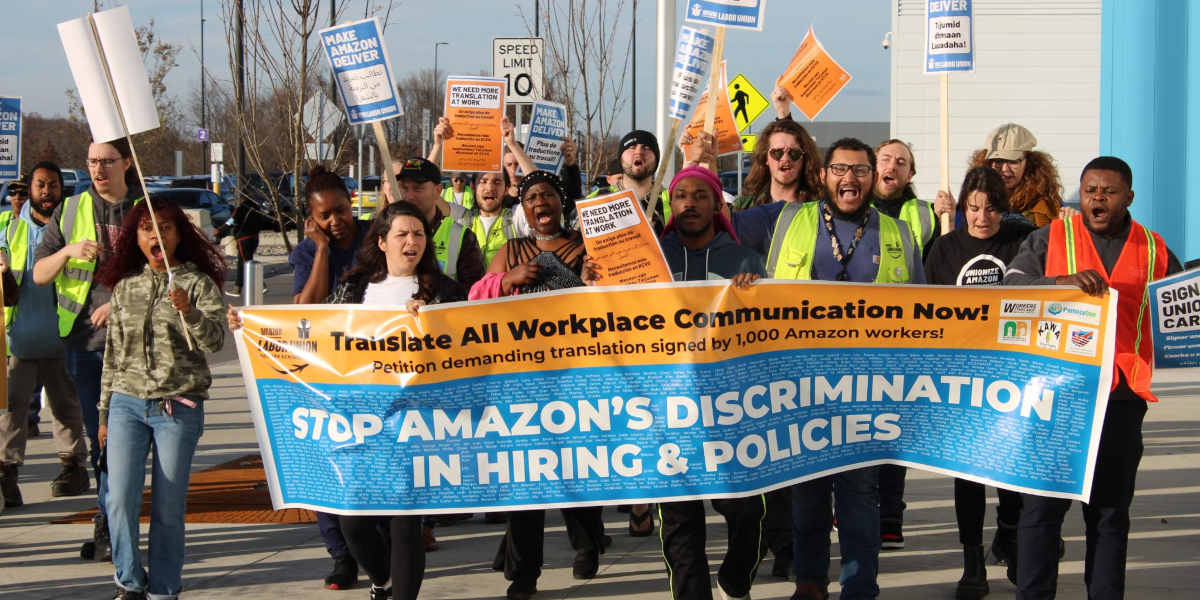When will Amazon workers around the world enjoy collective bargaining agreements with good pay, union job rights, and safety protections?
The challenges facing this lofty goal remain daunting. One only needs to look at the pictures of Amazon founder Jeff Bezos mingling with his fellow centi-billionaires at Trump’s inauguration to understand that workers are up against the merged power of private corporations and hostile governments.
In 2024, Amazon’s relentless union-busting narrowly defeated a union certification election at the massive BHX4 warehouse in Coventry, who narrowly lost their July union election by one percentage point out of nearly 3,000 ballots cast. In the US, where Amazon workers at the JFK8 warehouse in New York won a union election in 2022, company manipulation of the legal process has blocked bargaining. Amazon delivery drivers and warehouse workers at a handful of US sites have demanded direct recognition and bargaining – only to be ignored by the company, which has an army of union-busting lawyers and political establishment friends to insulate them from any legal obligations.
Lessons from Coventry
Yet in the last year, Amazon workers took important steps forward, demonstrating worker power through direct, collective action. These are the building blocks for what it will take to prevail over time.
Last September, on the heels of strikes at Coventry warehouses and the close BHX4 election, Amazon workers throughout the UK saw their biggest pay rise yet of £1.20/hour, or almost 10 percent. It wasn’t corporate generosity, rather, it came after the near-victory by the Coventry workers alongside several strikes at Coventry over the last two years, totaling 38 days, along with job actions at an increasing number of UK warehouses.
Strikes – even minority strikes – have proven to be effective organising steps. The Coventry pickets jammed up traffic outside the warehouse. In many cases commuting workers initially were unaware or – or even unsupportive – of the strike. But as Coventry worker Ceferina Floresca described it, ‘we stopped the cars, we talked to our co-workers, and some of them joined the union right there, if there were several of them in the car. The others would just get out of the car and then go to the tent to register (to join the union) directly. We recruited a lot of people from the day of the strike itself’.
After Amazon announced the £1.20 pay rise, when the Coventry workers talked to workers at other warehouses, they noted that ‘you got a pay rise from our efforts in that strike wave’, said Coventry union leader Garfield Hylton.
Power in a union
Likewise, one-million-plus US Amazon warehouse workers and drivers also saw a large pay rise in 2024 of $1.50/hour following one-day strikes at several facilities. As in the UK, the US wage victory was a corporate concession to worker power, coming in the wake of numerous shop floor skirmishes. At the company’s massive KCVG air cargo hub in Kentucky, workers organised three different marches on the boss and did a workplace sticker-up to win health insurance and paid time off for hundreds of colleagues who had been denied those benefits as ‘seasonal’ hires.
‘The marches on the boss grew in size every time, forcing Amazon to concede’, said Josh Crowell, a KCVG worker. ‘The victory inspired coworkers to fight for more and led to our largest actions a few months later’, including a one-day walkout that stifled production at the air cargo centre. ‘The biggest lesson was for permanent workers to fight alongside their seasonal counterparts, showing that an injury to one is an injury to all’, Crowell said.
At the San Bernardino, California air cargo hub, workers organised a march on the boss when smoke from nearby wildfires came into the building. The workers won paid time off until the health risk had abated.
It will take nothing short of an all-in commitment from international labour to win union contracts throughout Amazon
At the tail end of Amazon’s Peak season in late December, workers in San Bernardino, Staten Island, and five delivery stations walked off the job. The number of actual US strikers was quite small – best estimates put it at about 600 workers total – but as with other minority Amazon strikes, the American walkouts demonstrated growing worker confidence.
And in India, Amazon warehouse and delivery workers in the Amazon India Workers Union have staged direct actions and used social media to expose horrific working conditions. As a result, the union’s Dharmendra Kumar told me, workers at the huge DEL4 warehouse outside Delhi forced the company to agree to stop work during extreme heat, increase access to water, set up a new cafeteria for workers and hire a female nurse for women workers.
These achievements fall well short of what Amazon workers fully deserve, but they reflect a perceptible shift in the balance of power. The company’s valuation is a staggering £1.6 trillion and founder Jeff Bezos is personally worth a sickening £164 billion, but the strikes and direct actions show that it still takes labour power to move packages. Increasingly workers are recognizing that the company’s just-in-time logistics model, while brutal to the human body and spirit, gives them significant leverage – if they are prepared to unite and act.
Strategies for victory
What will it take to beat Amazon? Much more of what we’ve seen this past year, escalating to disruptive actions sustained over time and coordinated systematically on a global scale.
To get there, we will need union drives that embrace three principles: First, a class-struggle organising approach, recognizing that this is a fight between two opposing interests: Amazon workers, who demand the full fruits of their labor and rights at work, and their bosses, who want to maximize profit and control. Second, the movement must be driven by bold, concrete demands that clarify what is at stake. Amazon workers have shown they will make extraordinary sacrifices if they are strongly motivated by the prospect of changing their lives. And third, there must be thorough and democratic shop-floor organising. There are no shortcuts to building the strength and resiliency necessary to withstand the blows of Amazon’s union busters.
This must be a coordinated, global effort. In January, Amazon announced it was shutting down all seven of its warehouses in Quebec, transparently a union-busting response to workers winning certification at a single Montreal warehouse. In February, the company defeated a union election at the RDU1 warehouse in North Carolina with a torrent of mandatory brainwashing sessions, firings and even arrests of union organisers, and fear-mongering immigrant workers with the spectre of deportation. Amazon’s scorched-earth counterattack underscores the need to build campaigns across regions and national borders; it will not be sufficient to organise single sites.
It’s good that big unions like Unite in the UK, the Teamsters in the US, Ver.di in Germany, and the Uni Global Federation have begun to increase campaign support, but much more is needed. Amazon is arguably the most powerful company in the history of capitalism. It will take nothing short of an all-in commitment from international labour to win union contracts throughout Amazon. In 2024, workers showed us that the moment is ripe for such a global movement.










